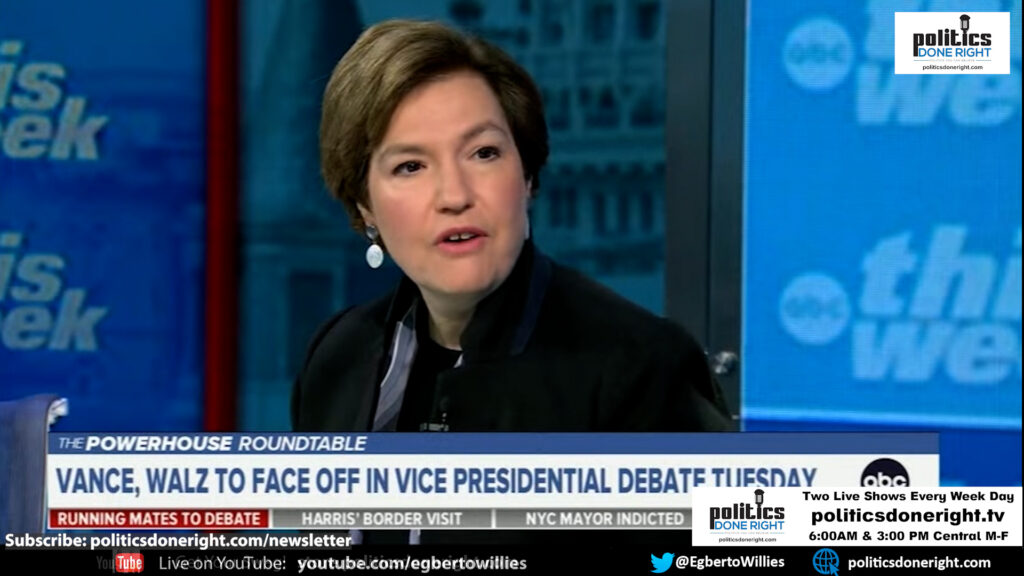The New Yorker staff reporter Susan Glasser said out loud what many a mainstream journalist refuses to speak. Donald Trump’s policy positions are just a magical wand.
A journalist shames the mainstream media.
Podcasts (Video — Audio)
In an era dominated by sensationalist headlines and shallow political analysis, it’s rare to find a journalist brave enough to challenge the political establishment and the media’s complicity in misleading narratives. Susan Glasser, a staff writer for The New Yorker, finally broke that silence, offering a critique not only of Donald Trump‘s vacuous policy claims but also of the mainstream media’s failure to hold him to account adequately. Her commentary highlights the media’s complicity in elevating Trump’s so-called “magic wand” solutions while simultaneously applying a different standard to more progressive figures like Kamala Harris.
In the video, Glasser exposes a glaring double standard in how the press treats political figures. Kamala Harris, for instance, is frequently scrutinized and pressed for detailed policy proposals, while Trump is given a pass for making sweeping, unrealistic claims without any substantive follow-through. Trump’s proposals, such as ending the war in Ukraine within 24 hours or reviving the economy through massive tariffs, are not based on concrete plans. Yet the media rarely questions the specifics of how he would achieve these lofty goals.
This double standard is not just a failure of journalism—it is a betrayal of public trust. The media is supposed to be a watchdog, holding those in power accountable. But too often, mainstream outlets shy away from hard-hitting critiques of right-wing figures like Trump. Instead, they allow Trump’s vague and often misleading rhetoric to dominate the discourse, all to maintain so-called “balance” or avoid accusations of bias.
One of the most telling examples of this failure is the way the media continues to treat Trump’s economic legacy. Trump frequently claims that the economy was stronger under his administration, and the media dutifully repeats these claims without context. In reality, Trump’s mishandling of the COVID-19 pandemic contributed significantly to the economic downturn, including supply chain disruptions and a surge in corporate profiteering that led to “greedflation.” Corporations took advantage of the chaos, raising prices under the guise of supply chain issues, even as the underlying problems eased. The media, rather than challenge this narrative, allowed Trump to frame himself as a savior of the economy despite his role in its collapse.
Moreover, Trump’s promises to impose tariffs to boost the economy are a classic example of his “magic wand” approach to policy. His supporters believe these tariffs will punish China and bring back jobs to the U.S. However, what Trump fails to mention—and what the media often ignores—is that American consumers ultimately pay tariffs in the form of higher prices. Instead of asking hard questions about the real economic impact of these tariffs, the media often lets Trump’s simplistic rhetoric go unchecked.
This lack of scrutiny has profound consequences. As Glasser points out, millions of Americans have internalized Trump’s false narratives. People believe the economy was better under Trump, not because of any real improvement in their material conditions, but because Trump’s message has been repeated without challenge. The media, in its quest for balance, has allowed Trump’s version of reality to dominate, even when it is demonstrably false.
This is a failure of individual journalists and the entire media ecosystem. The mainstream media often takes its cues from the right-wing press, adopting its framing and narratives. When the right accuses Kamala Harris of not providing enough policy specifics, the mainstream media parrots this claim without acknowledging the hypocrisy of not demanding the same level of detail from Trump. This creates a skewed playing field, where progressive politicians are held to an impossibly high standard while right-wing figures are given a free pass.
The result is a distorted political landscape where the public is misinformed and misled. Critical thinking is more important than ever in this environment. Americans must ask hard questions about the proposed policies, whether they come from the left or the right. However, the media must also do its part by refusing to accept simplistic, magical solutions without challenge.
Glasser’s commentary is fresh air in a media landscape too often dominated by shallow analysis and false equivalency. She calls out both Trump’s empty promises and the media’s failure to hold him accountable, offering a scathing critique of the political and journalistic establishment. It is a call to action for journalists everywhere: stop letting Trump’s “magic wand” policies go unchallenged and start demanding real answers.
The mainstream media’s failure to critically evaluate Trump’s policies while simultaneously holding progressive politicians to a higher standard has contributed to a deeply distorted political discourse. Susan Glasser’s critique should serve as a wake-up call for journalists to return to their role as watchdogs of democracy, holding all politicians accountable, regardless of their party or ideology. The American public deserves better, and the media is responsible for providing it. We can only begin to restore some semblance of truth to our political discourse by challenging these misleading narratives.

